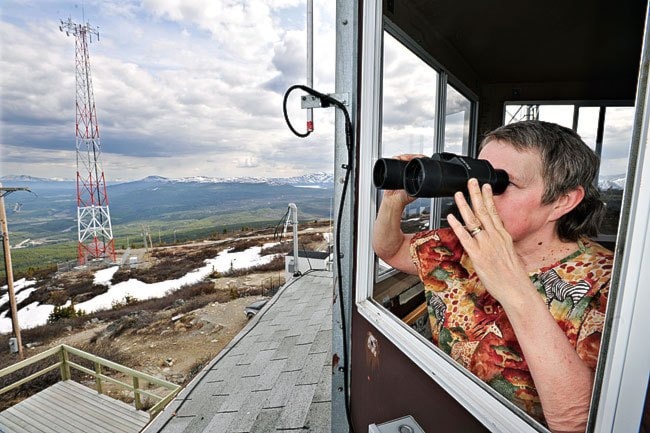Three Yukon fire towers will remain shuttered this summer.
Ptarmigan in Carmacks, Paint Mountain in Haines Junction and one of Watson Lake’s two fire towers are no longer needed, said Ken Colbert, the Yukon government’s director of wildland fire management.
New technology, including more satellites and cellphones, has made the towers redundant, he said Tuesday.
“We have a lot of people with cellphones and the public is good at reporting fires,” he said.
“And we have done a lot of Firesmarting around the communities, which has reduced the threat of fires.”
The government has also been “more conscientious” with its air patrols, said Colbert. “And we get a lot more reports that way than we would have with towers.”
In fact, one of the towers only reported one fire in the last six years, he said.
“And each tower costs about $50,000 a year to operate.”
There were also staffing concerns with the towers, said Colbert. “We had personnel in a situation where they could not get immediate medical attention.”
Flying in to the towers also proves risky at times.
“We tried to fly in to one tower in 2004 and couldn’t get in because of the weather,” he said. “And I reflected later how risky that had been.”
Of the three personnel who spent their summers in the towers, only one is out of a job.
One employee was no longer able to do it for medical reasons, said Colbert. “Another has been reassigned to a different tower because we had a vacancy. And we are trying to figure out something for the third person,” he said.
The towers will still be used when needed, he added. “If there are fires in the area that need extra monitoring or if we’re expecting lightning storms, they will be manned up.”
The expense of extra plane and helicopter flights to monitor the regions won’t necessarily eat up the money saved closing the towers, added Colbert.
“When there are significant events, we take on helicopters and aircraft,” he said. “And we’re paying a daily minimum anyway, so we might as well use it.”
Wildland fire management is also replacing its 1950s-era DC6 with an Electra L188 this year.
“It’s an older plane, too,” said Colbert. “But it’s well maintained.”
And most importantly, it runs on turbo fuel, he said.
Until now, the Yukon’s fire fleet has run on aviation gas, which made it difficult to export the planes during slow fire seasons.
“To keep in step with our partners in Western Canada, we needed planes that run on turbo fuel,” said Colbert.
A new bird-dog plane is being purchased this year to accompany the Electra L188. And next year, the Yukon’s three Firecats will be replaced, he said.
The government is also investing in new cell- and satellite-phone technology.
“Like every organization, we’re evolving,” said Colbert. “And items that are no longer cost-effective are being ruled out.”
The Yukon still has six manned fire towers.
But as staffing vacancies arise, these too may end up shuttered.
“If there are vacancies or infrastructure needs to be replaced, we’ll review the tower,” said Colbert.
Contact Genesee Keevil at
gkeevil@yukon-news.com
